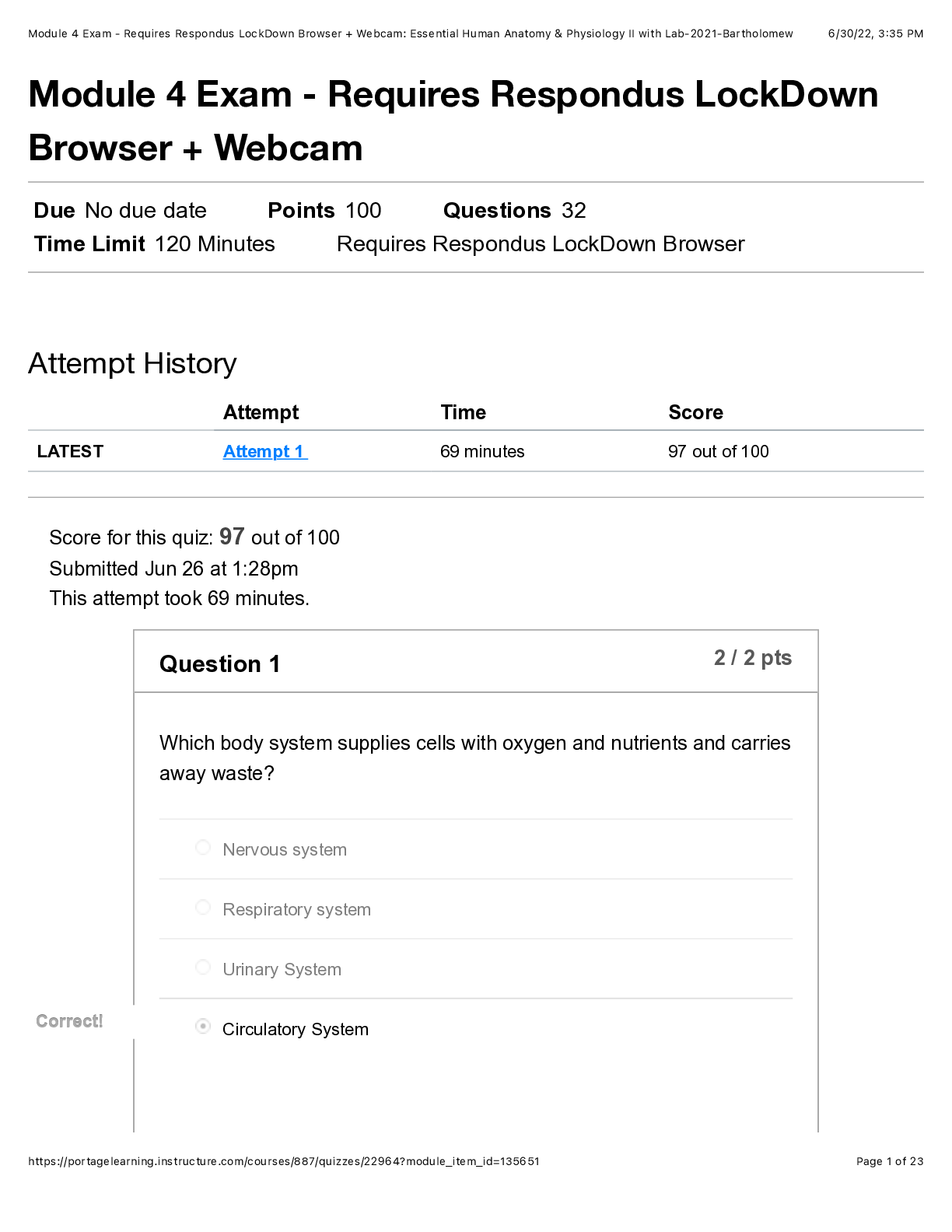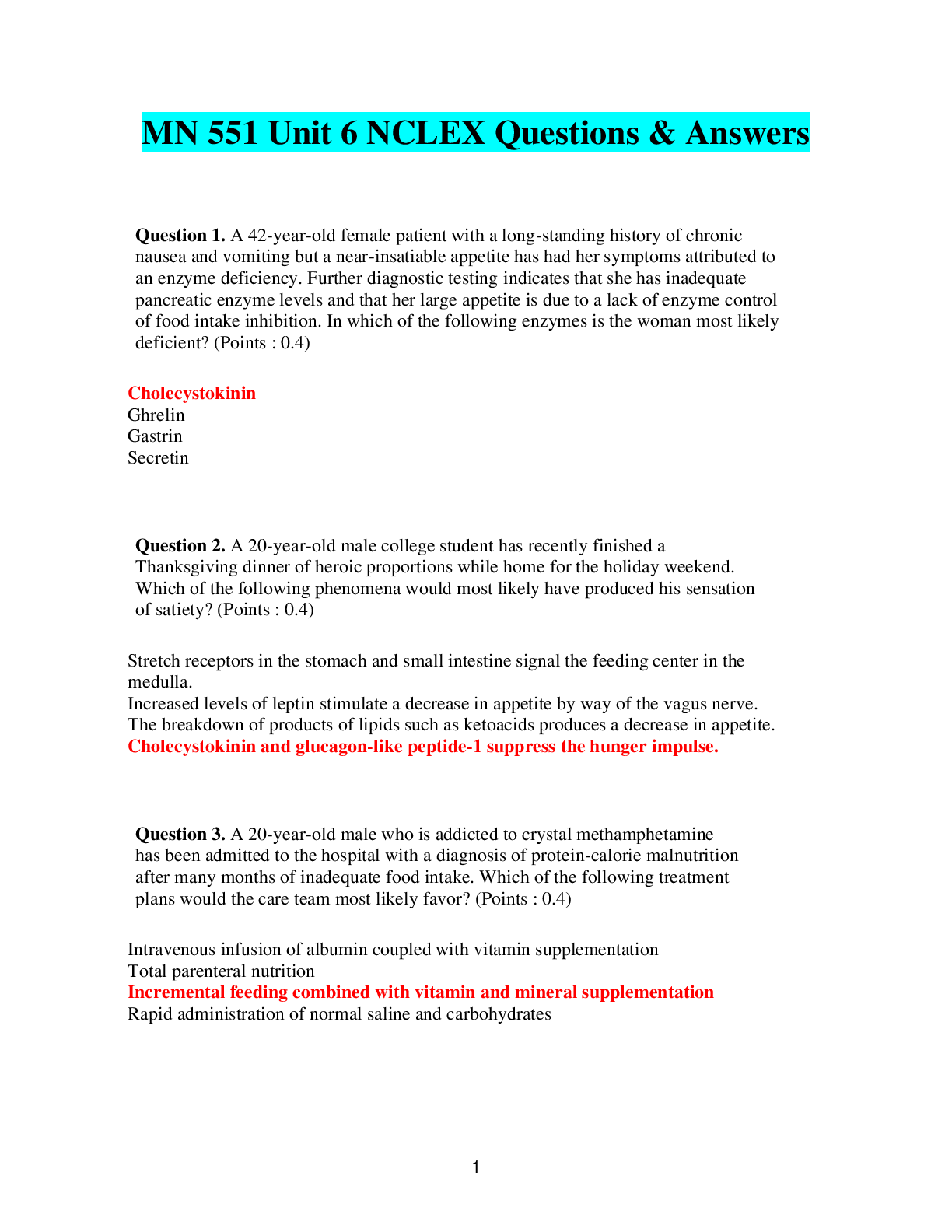Religious Studies > QUESTIONS & ANSWERS > Liberty University - HIEU 201 > Western Civilization Latest Quiz (Latest) - Already Graded A (All)
Liberty University - HIEU 201 > Western Civilization Latest Quiz (Latest) - Already Graded A
Document Content and Description Below
Chapter 1 quiz Western Civilization 1.Paleolithic religious beliefs a. did not include belief in life after death. b. made a clear distinction between nature and the supernatural. c. centered arou... nd the idea that human beings needed to appease the forces of nature. d. centered around the idea that forces of nature had been created to serve human beings. 2.Which of the following is NOT a feature of the Neolithic Age? a. Human beings domesticated animals. b. Human beings established villages. c. Human beings discovered farming. d. Human beings started using iron tools. 3.The first civilizations a. abandoned the monumental architecture of prehistoric cultures. b. did not yet possess specialization of labor. c. developed systems for administration, cooperation, and record-keeping. d. lacked organized governments. 4. Sargon the Great a. conquered territories, plundered their resources, and then left to find new opportunities for conquest. b. contributed to the spread of Sumerian culture beyond the boundaries of Mesopotamia. c. was known for his policy of pursuing peace at any cost. d. was the leader of an important Sumerian city-state. 5.The Sumerians erected their religious temples atop huge multilevel mounds called a. cuneiform. b. ziggurats. c. Nammu. d. stele. 6.The kings in ancient Mesopotamia a. were viewed as being above the law and absolute in their power. b. were believed to be living gods. c. were rulers thought to have been selected by the gods to represent them on earth. d. were replaced by democracies governed by elders and assemblies of citizens. 7.The economy of Mesopotamian cities a. was conducted by a state bureaucracy. b. was entirely self-sufficient. c. depended heavily on foreign and domestic trade. d. was largely unregulated. 8.Which of the following describes the Egyptians' relationship with their environment? a. The challenges of nature were designed to punish human beings. b. The lack of natural boundaries subjected Egyptians to constant invasion and change. c. The unpredictability of the Nile made Egyptian life precarious. d. Nature served as a source of security. 9.The pharaohs a. technically owned no earthly possessions. b. had little impact on the lives of peasants and workers. c. communicated the gods' will to the Egyptian people. d. were elected by a noble class. 10.The Hittites a. were absorbed into Babylonian civilization. b. rejected all aspects of foreign culture. c. achieved no substantial technological progression. d. ruled Asia Minor and northern Syria. 11.Which of the following is NOT true of the Persian empire? a. It allowed local elites a large measure of self-rule. b. It developed an effective administrative system of twenty provinces. c. It was bound together by a uniform language, Aramaic. d. It was ruled by a council thought to represent the people. 12. Compared to a rational or scientific view of the world, a mythopoeic view a. sees the world of nature as an entity, like a machine, rather than a living being. b. is more logically consistent than the rational view developed by the Greeks. c. shows little imagination or emotion in interpreting nature. d. appeals primarily to the emotions rather than reason and tends to be more subjective than objective. 13.The ________ Age is also known as the Old Stone Age. a. Classical b. Archaic c. Paleolithic d. Neolithic Which of the following civilizations rose first? a. Phoenician b. Sumerian c. Hittite d. Assyrian The Epic of Gligamesh depicts the Mesopotamians' mood of a. optimism and hope. b. sensuality and emotionality. c. pessimism and despair. d. stoicism and tranquility. In Paleolithic societies, human beings a. obtained the necessities of life by gathering food and hunting. b. lived in large permanent settlements of several thousand people. c. were unable to communicate with one another by language. d. had not yet acquired the ability to make tools. The central force in the first civilizations was a. popularly-selected governance. b. religion. c. iron technology. d. science. In Hammurabi's code of law a. crimes against nobles were punished more severely than crimes against commoners. Correct b. the king was not bound by the law, but might legally do whatever he wished to do. c. women enjoyed a legal status equal to that of men. d. women and children had no legal protection. The religious teachings of the prophet Zoroaster a. are a complex set of polytheistic beliefs based on magic and blood sacrifice. b. reject the need for ethics in human life. c. are dualistic, asserting the existence of both a good god and an evil god. d. represent the earliest known examples of monotheistic faith. The Egyptian New Kingdom began with the war of liberation against the a. Nubians. b. Assyrians. c. Hyksos. d. Babylonians. Chapter 2 quiz The biblical account of the Exodus identifies ________ as leading the Hebrews out of Egypt. a. Saul b. Moses c. David d. Abraham Under the rule of David's son Solomon, a. old tribal patterns gained renewed strength. b. Israel reached the height of its power and prosperity. c. the Israelites lost Jerusalem to the Philistines. d. Jerusalem decreased in importance [Show More]
Last updated: 2 years ago
Preview 1 out of 11 pages

Buy this document to get the full access instantly
Instant Download Access after purchase
Buy NowInstant download
We Accept:

Reviews( 0 )
$7.00
Can't find what you want? Try our AI powered Search
Document information
Connected school, study & course
About the document
Uploaded On
Oct 09, 2022
Number of pages
11
Written in
Additional information
This document has been written for:
Uploaded
Oct 09, 2022
Downloads
0
Views
113



 (1).png)
.png)















